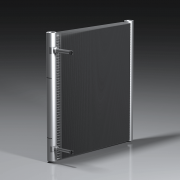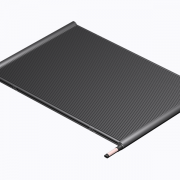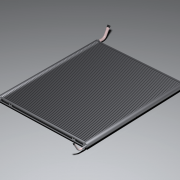Refrigerant distribution optimization for microchannel evaporators
Microchannel evaporators are being increasingly used in air conditioning and refrigeration systems, since they aid in reducing refrigerant charge, enhancing heat transfer performance, lowering tube-side pressure drop, and reducing system size. However, as with other types of evaporators, microchannel evaporators face the issue of refrigerant maldistribution. This phenomenon leads to unequal superheated vapor at tube exits and prevents optimum utilization of the heat exchanger surface.
***
In microchannel evaporators, refrigerant flow maldistribution can be classified into two types:
- Refrigerant quality-induced maldistribution
- Manifold pressure drop-induced maldistribution
Quality-induced Maldistribution
The first type of maldistribution, quality-induced, is caused by a two-phase flow created during the isenthalpic expansion process. The idea behind flash gas bypassing (FGB) is to separate vapor and liquid refrigerant in a flash tank installed downstream of the expansion valve and pass gaseous refrigerant around the evaporator, feeding the evaporator with liquid refrigerant only. Following this concept, the distribution rating parameter (DRP, as per C.D. Bowers et al., 2010) rises from 0.68-0.70 for direct expansion mode with a two-phase inlet to 0.87-0.89 for liquid-only flooded mode. Pressure drop at the inlet header is also reduced in flooded evaporation mode. This contributes to higher system efficiency and increases evaporator capacity by around 7% and 8%, respectively, when operated at identical conditions. Even larger performance improvements can be achieved for systems running on variable-speed compressors.
Figure 1: Evaporator distribution rating
Another possibility for an even refrigerant flow is the homogenization of the two-phase flow through a distributor before feeding multiport tubes. This design is used in the current generation of microchannel evaporators offered by Kaltra.
Further distribution improvements lie in implementing an evaporator design with even pressure differences across microchannel tubes.
Pressure Drop-induced Maldistribution
However, the refrigerant distribution of single-phase fluid between multiport microchannel tubes is also imperfect – as a consequence of the pressure drop deltas along headers. Here, the pressure drop delta along the outlet header is far higher than that along the inlet header, mainly because vapor refrigerant flows along the outlet header with very high velocity, especially where vapor streams from multiport tubes combine closer to the evaporator outlet. Pressure differential and corresponding mass flow across multiport tubes gradually increase in the outlet flow direction, causing less superheated zones on downstream tubes.
Figure 2: Evaporator distribution profile (A)
Figure 3: Evaporator distribution profile (B)
Three main parameters which mainly determine the outlet header pressure drop are:
- Outlet header hydraulic diameter
- Port size of microchannel tube
- Heat exchanger width-to-height aspect ratio
Header Hydraulic Diameter
Tests were performed with different outlet header diameters ranging from 1.0 to 2.0 times larger than the inlet header diameter, with the inlet header diameter remaining constant. During tests, liquid mass flow rates for each microchannel tube were measured as a function of the outlet header diameter and it was evident that as the diameter increased, the liquid mass flow profile became more uniform due to the decreasing pressure drop in the outlet header causing equalization of pressure drops across microchannel tubes as well.
Figure 4: Evaporator header diameter vs. surface temperature
When enlarging the outlet header diameter, the superheated area decreases and appears in a more uniform pattern, indicating improvements in refrigerant distribution among microchannel tubes.
Microchannel Port Size
Increasing microchannel tube pressure drop also reduces the negative impact of pressure drop differential in headers on evaporator performance. As pressure drop in tubes increases, the ratio of outlet header pressure drop differential is reduced, leading to equalization of mass flow among the tubes. However, excessive reduction in port size will lead to capacity degradation due to high growth of pressure losses along tubes and the negative impact of temperature difference reduction.
Figure 5: Evaporator port size vs. surface temperature
Field experiments included evaporators with port hydraulic diameters ranging from 0.8mm² to 0.4mm².
Evaporator Aspect Ratio
Vertical tube orientation is preferable for microchannel evaporator coils for reasons such as improvements in performance and free condensate drainage. In this type of design, the aspect ratio is defined as the length of microchannel tubes (heat exchanger height) to header length (heat exchanger width) proportion. Thus, a higher aspect ratio means fewer longer tubes are used in evaporator construction and, consequently, its headers are shorter. This results in a lower pressure drop differential in headers and a higher one in tubes, improving liquid distribution and evaporator capacity. At the same time, an excessive increase in aspect ratio leads to the consequence of an unacceptable pressure drop.
Conclusion
Experimental results reveal that header-induced mass flow maldistribution still exists when the quality-induced maldistribution is almost eliminated by bypassing flashing vapor and feeding the evaporator with liquid-only refrigerant. This impact can be reduced to a minimum by regulating the hydraulic diameter of the outlet header and tube port sizes and by selecting the optimum height-to-width aspect ratio of the evaporator.
Figure 6: Evaporator geometry optimization
The distribution of two-phase refrigerant is affected mostly by different the thermophysical properties of liquid and vapor and resultant forces like gravity and inertia. This can be eliminated by using the flash gas bypass (FGB) method of feeding the evaporator coil with liquid-only refrigerant.









